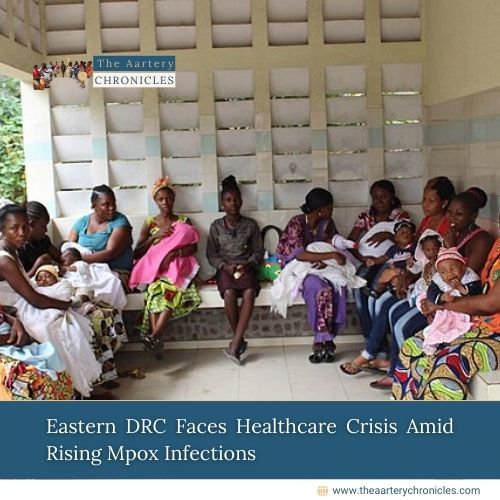

Eastern DRC Faces Healthcare Crisis Amid Rising Mpox Infections
The Democratic Republic of Congo (DRC) is currently experiencing a significant surge in mpox cases, with the eastern region being particularly hard-hit. Hospitals in the area are struggling to provide adequate care due to severe shortages of medicine and space, leaving healthcare workers overwhelmed and patients in desperate need of support.
Kavumu Hospital Faces Critical Shortages
The situation is dire at the hospital in Kavumu, a small town in the DRC. Over the past three months, the facility has admitted 900 patients showing symptoms of mpox. Despite their best efforts, health workers are grappling with a lack of resources. According to Dr. Musole Mulamba Muva, the head doctor at the hospital, they are running out of medicine daily, and the influx of patients has outpaced the hospital’s capacity. Last week, 135 patients, including both children and adults, were crammed into three large plastic tents erected on the damp ground, with no proper flooring.
Food and Medicine Shortages Affect Patients
In the DRC, it’s common for relatives to provide meals for patients in underfunded public hospitals. However, due to the risk of contamination, relatives have been banned from visiting the mpox ward. This has left patients, particularly children, without adequate food. One mother, Nzigire Lukangira, whose toddler is hospitalized, expressed her frustration, stating that even when they ask for medicine to reduce their children’s fever, they receive nothing. Many mothers in the ward have resorted to using traditional remedies, such as potassium bicarbonate and salty lemon juice, to treat their children’s symptoms.
Government and International Response
The DRC has been identified as the epicentre of a global mpox outbreak, which the World Health Organization (WHO) recently declared a public health emergency. In response, vaccines are expected to arrive in the country within days, and President Felix Tshisekedi has approved an initial $10 million to combat the outbreak. Cris Kacita, the head of the DRC’s mpox response team, acknowledged the challenges in distributing medicine across the vast country but emphasized that delivering 115 tonnes of medicine donated by the World Bank is a priority.
The Current State of the Outbreak
Since the beginning of the year, the DRC’s health ministry has reported 19,710 suspected cases of mpox, of which 5,041 have been confirmed. Tragically, 655 of these cases have been fatal. The disease, which causes flu-like symptoms and pus-filled lesions, can be deadly, especially for children, pregnant women, and individuals with weakened immune systems. Efforts to combat the outbreak continue, with high-risk areas and priority groups identified for the first phase of vaccination.
Understanding Mpox (Monkeypox)
What is Mpox?
Mpox, earlier known as monkeypox, is a rare viral disease caused by the mpox virus. It primarily affects rodents like rats and mice, as well as non-human primates such as monkeys, but can also infect humans.
Where Does Mpox Occur?
Mpox is mostly found in Central and West Africa, particularly near tropical rainforests where animals carrying the virus live. However, since 2022, cases have been reported in regions outside Africa, including the United States and Europe, due to factors such as international travel and close contact with infected animals or people.
Symptoms of Mpox
Symptoms typically appear 3 to 17 days after exposure to the virus which include:
- Fever
- Skin rash
- Swollen lymph nodes
- Headaches
- Muscle aches and back pain
- Chills
- Fatigue
How Does Mpox Spread?
Transmission from Animals to Humans:
- Direct contact with body fluids, lesions, or rashes of infected animals.
- Animal bites or scratches.
- Consumption of undercooked wild game.
- Handling products like skins or furs from infected animals.
Human-to-Human Transmission:
- Direct contact with an infected person’s rashes, scabs, or body fluid.
- Prolonged close contact with respiratory droplets, notably during sexual encounters.
- Contact with contaminated items like clothing or bedding.
- Transmission from an infected pregnant person to their fetus.
Prevention of Mpox
Key Preventive Measures:
- Avoid close contact with individuals showing symptoms or rashes that resemble mpox.
- Do not handle materials (e.g., clothes, blankets) that have been in contact with infected persons or animals.
- Isolate infected individuals from those who are healthy.
- Avoid contact with animals
Vaccination:
- Certain smallpox vaccines, like ACAM2000 and Jynneos, can prevent mpox because of the virus’s relation to smallpox. Vaccination is recommended for those exposed to mpox or at high risks, such as lab workers. However, routine vaccination for the general public is not currently recommended by the CDC.
- The vaccine can also be used after exposure to someone with mpox as a form of post-exposure prophylaxis. Ideally, it should be administered within 4 days of contact. However, if the exposed person has not developed symptoms, the vaccine can still be given up to 14 days after exposure.
Treatment of Mpox
Symptomatic Care:
- Treatment focuses on relieving symptoms such as managing skin damage from the rash, ensuring proper hydration, and pain management.
- Isolate at home, separate from family and pets, until the rash and scabs have fully healed.
Antiviral Treatment:
- Though there is no specific approved treatment for mpox, antiviral drugs used to treat smallpox, such as tecovirimat (TPOXX) or brincidofovir (Tembexa), may be used.
Source: Inputs from various media Sources









